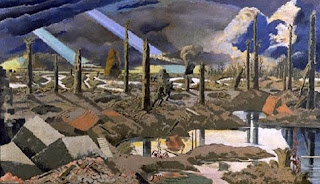C.R.W. Nevinson, "Paths of Glory" 1917. "Dulce et Decorum Est, Pro Patria Mori."
Nevinson, "Harvest of Battle" 1919. Blind leading the blind.
Nevinson, "Machine Gun," 1915. French soldiers.
Frank Branwyn, "Tank in Action" (1925) Painted for a public building in Britain. Rejected as "unacceptably morbid." In other words, too accurate.
Henri de Groux, "Gas Masks" (1916). French soldiers. Note resemblance to pigs. Asphyxiation by gas was perhaps the most horrible way of dying.
George Leroux, "L'Enfer" ("Hell") 1917, Suitably named. Artillery killed more men than any other weapon.
William Orpen, "Dead Germans in a Trench" 1918
Paul Nash, "The Menin Road" 1919
Nevinson, "Taube" 1916. Child killed by German aerial bombing. Total War.









No comments:
Post a Comment